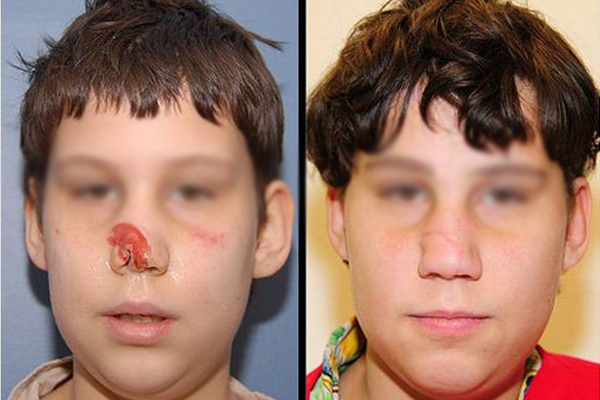Nasal reconstruction
Nasal reconstruction is a specialized surgical procedure aimed at restoring the structure, function, and appearance of the nose. It is often required following trauma, congenital deformities, cancer excision, or other medical conditions that result in nasal defects.
Indications for Nasal Reconstruction
-
Trauma:
- Injuries from accidents, falls, or sports-related incidents causing structural damage.
-
Cancer Excision:
- Post-surgical defects from skin cancer removal (e.g., basal cell carcinoma, squamous cell carcinoma).
-
Congenital Defects:
- Conditions such as cleft nose or other birth-related abnormalities.
-
Infections or Diseases:
- Damage caused by chronic infections or autoimmune diseases (e.g., Wegener’s granulomatosis).
-
Aesthetic Restoration:
- For deformities resulting from previous surgeries or trauma.
Goals of Nasal Reconstruction
- Restore nasal function, including proper airflow and breathing.
- Rebuild the nose’s structural framework.
- Achieve a natural, aesthetically pleasing appearance.
- Minimize visible scarring.
Techniques Used in Nasal Reconstruction
-
Local Flaps:
- Tissues from nearby areas of the face (cheeks, forehead) are used to cover nasal defects.
- Commonly used for small to moderate defects.
-
Skin Grafts:
- Thin layers of skin harvested from other parts of the body (e.g., behind the ear).
- Used for surface coverage when local flaps are insufficient.
-
Cartilage Grafts:
- Cartilage taken from the septum, ear, or rib to rebuild the nose’s framework.
- Provides structural support and shape.
-
Forehead Flap Reconstruction:
- Tissue from the forehead is used for larger or complex defects.
- Offers excellent color and texture match.
-
Free Flap Reconstruction:
- Tissues with their own blood supply are transferred from distant parts of the body.
- Used in extensive nasal defects requiring significant reconstruction.
-
Implants and Prosthetics:
- Synthetic materials or prosthetic devices are used when natural tissues are unavailable.
-
Staged Reconstruction:
- Large or complex reconstructions may require multiple surgeries.
Procedure Overview
1. Preoperative Planning
- Detailed evaluation of the defect, nasal anatomy, and patient’s medical history.
- Imaging studies (CT or MRI) may be used for complex cases.
- Discussion of aesthetic goals and functional needs.
2. Surgery
- Performed under local or general anesthesia, depending on the extent of reconstruction.
- Techniques vary based on defect size, location, and tissue availability.
3. Duration
- Surgery duration ranges from 1-6 hours, depending on complexity.
Recovery Process
-
Initial Recovery:
- Swelling, bruising, and mild discomfort are common in the first 1-2 weeks.
- Nasal splints or dressings may be applied to protect the reconstructed area.
-
Activity Restrictions:
- Avoid strenuous activities, nose-blowing, and pressure on the nose for several weeks.
-
Long-Term Healing:
- Full recovery and final results may take several months as swelling subsides and tissues settle.
Benefits of Nasal Reconstruction
- Restores both aesthetic and functional aspects of the nose.
- Enhances self-confidence and quality of life.
- Provides long-lasting or permanent results.
Risks and Complications
- Infection: Minimized with proper care and antibiotics.
- Scarring: Managed with advanced techniques and post-operative care.
- Asymmetry: Revision surgery may be required for refinement.
- Graft Failure: Rare but possible in complex cases.
Ideal Candidates
- Individuals with nasal defects from trauma, surgery, or congenital issues.
- Those in good overall health and non-smokers.
- People with realistic expectations about the outcome.



